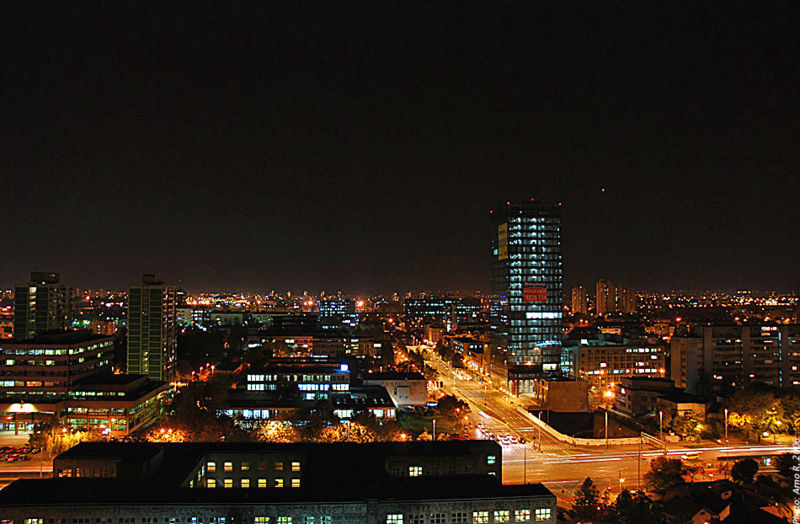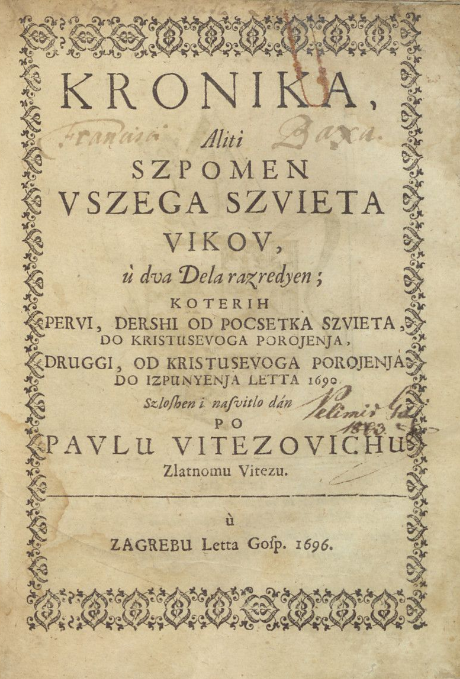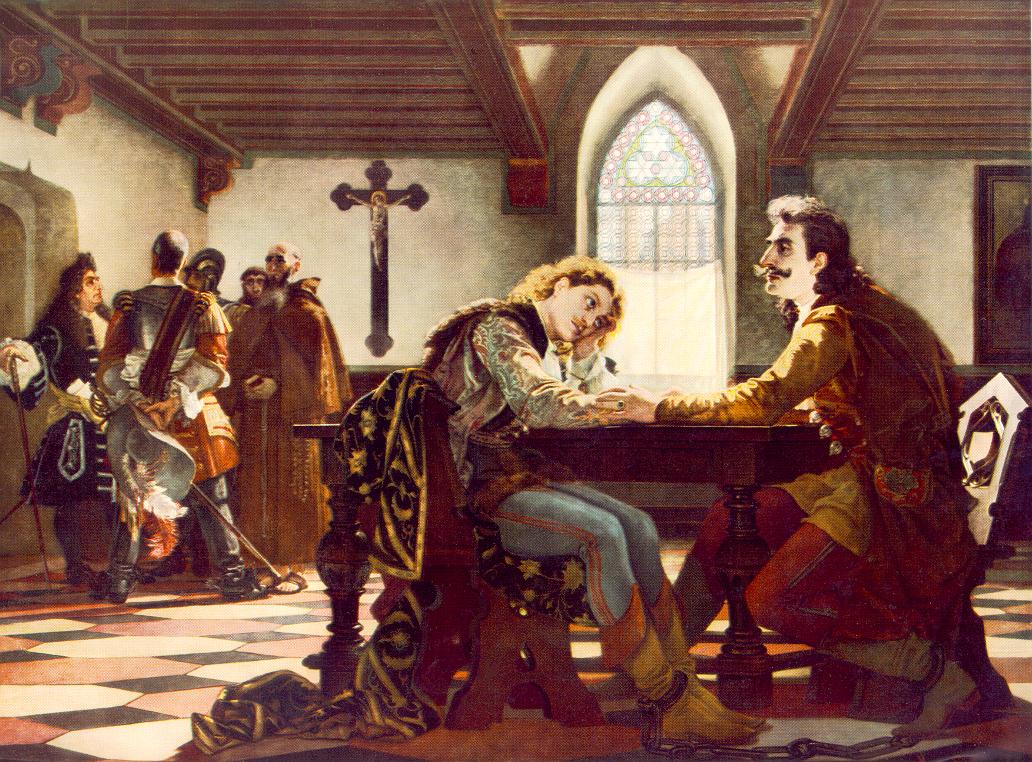|
Timeline Of Zagreb
The following is a timeline of the history of the city of Zagreb, Croatia. Prior to 19th century * 1st century – Andautonia was founded * 5th century – Andautonia was destroyed * 1094 – Diocese of Zagreb established by Ladislaus I of Hungary; Cathedral construction begins (approximate date). * 1242 ** Gradec and Gornji Grad besieged by Tatars. ** Golden Bull issued by Béla IV of Hungary; Gradec becomes a royal free city. * 1261 – Gradec fortification walls constructed. * 1368 – Population: 2,810. * 1476 – Works begin on Kaptol fortification in August. Bishop Osvald of Zagreb Diocese permits residence of laypeople in Kaptol for defense purposes, leading to resistance among clergy. * 1479 – Kaptol fortification walls completed. * 1557 – Croatian Parliament convenes at Gradec. * 1573 – Matija Gubec, leader of the failed Croatian–Slovene peasant revolt, is executed. * 1607 ** Jesuit high school founded. ** National library founded. * 1621 – Zagreb desi ... [...More Info...] [...Related Items...] OR: [Wikipedia] [Google] [Baidu] |
History Of Zagreb
The history of Zagreb, the capital and largest city of Croatia, dates back to the Middle Ages. The Romans had built a settlement, Andautonia, in present-day Ščitarjevo. The name "Zagreb" was first used in 1094 at the founding of the Zagreb diocese in Kaptol, after the Slavs had arrived in the area. Zagreb became a free royal city in 1242. It was made the capital of Croatia in 1845 and elected its first mayor, Janko Kamauf, in 1851. According to the 2011 Croatian census, Zagreb had 792,875 inhabitants and was also Croatia's largest city by area. Prehistory Earliest evidence of humans in Zagreb and the surrounding region belongs to the Mousterian culture of Middle Palaeolithic. The Krapina Neanderthal site, the largest known sample of Neanderthal remains dating back to 125,000 years ago, is located north of the city. The Veternica cave in the suburbs of Zagreb was explored in the early 20th century. Remains of Mousterian Neanderthals dated to 50,000–100,000 years ago we ... [...More Info...] [...Related Items...] OR: [Wikipedia] [Google] [Baidu] |
Classical Gymnasium In Zagreb
The Classical Gymnasium ( hr, Klasična gimnazija) is a gymnasium high school (similar to a grammar school in England and Wales) situated in Zagreb, Croatia. It was founded by the Society of Jesus in 1607. In its first year it had 260 students and it operated on the basis of the Jesuit programme "Ratio atque institutio studiorum societatis Jesu". History It was founded in 1607 by the Jesuits, who had recently settled in the Kingdom of Croatia (Habsburg) and Slavonia within the Habsburg monarchy. The gymnasium began operation on the initiative of the Zagreb City Council, with the approval of the Croatian Parliament (Sabor) and strong support of Ban of Croatia Ivan Drašković. Jesuit Ivan Žanić became its first rector, with 260 students enrolling in its first year. The gymnasium official opened on June 3, 1607, in a ceremony attended by Bishop of Zagreb Šimun Bratulić, ban Ivan Drašković and others. On the day of the opening ceremony, a Latin Language drama "Actio comica" wa ... [...More Info...] [...Related Items...] OR: [Wikipedia] [Google] [Baidu] |
Mihalj Šilobod Bolšić
Mihalj Šilobod Bolšić (1 November 1724 – 4 April 1787) was a Croatian Roman Catholic priest, mathematician, writer, and musical theorist primarily known for writing the first Croatian arithmetics textbook '' Arithmetika Horvatzka'' (published in Zagreb, 1758). Biography Mihalj was born in Podgrađe Podokićko on 1 November 1724 as the son of Andrija Šilobod and Margareta Gunarić (Guunarich). He was baptised one day later at the local church as evidenced by an extract from the register of baptisms for Mihalj Šilobod, located at the parish in Podgrađe Podokićko. Andrija Šilobod was then a prominent senior member of the Karlovac Military Generalate of the Slunj regiment. From 1735 to 1739, Andrija participated in military operations against the Turks, as was required by the Habsburg Kingdom of Croatia. Mihalj's brother, Ivan (Johan) Šilobod, was also a soldier in the Slunj infantry. Andrija and Ivan were awarded nobility by Queen Maria Theresa of Austria in 1758 fo ... [...More Info...] [...Related Items...] OR: [Wikipedia] [Google] [Baidu] |
Arithmetic
Arithmetic () is an elementary part of mathematics that consists of the study of the properties of the traditional operations on numbers— addition, subtraction, multiplication, division, exponentiation, and extraction of roots. In the 19th century, Italian mathematician Giuseppe Peano formalized arithmetic with his Peano axioms, which are highly important to the field of mathematical logic today. History The prehistory of arithmetic is limited to a small number of artifacts, which may indicate the conception of addition and subtraction, the best-known being the Ishango bone from central Africa, dating from somewhere between 20,000 and 18,000 BC, although its interpretation is disputed. The earliest written records indicate the Egyptians and Babylonians used all the elementary arithmetic operations: addition, subtraction, multiplication, and division, as early as 2000 BC. These artifacts do not always reveal the specific process used for solving problems, but t ... [...More Info...] [...Related Items...] OR: [Wikipedia] [Google] [Baidu] |
Tituš Brezovački
Tituš Brezovački (January 4, 1757 – October 29, 1805) was a Croatian playwright, satirist and poet. Brezovački, as the great comedian of the period, wrote all of his dramatic works in Kajkavian dialect. His poems were chiefly written in German and Latin, but few of them have also been preserved in Ijekavian Štokavian, as if predicting the path of Croatian national revival. Biography He was born in Zagreb, schooled in Zagreb and Varaždin, and in 1774 he entered the Pauline Order. He initiated the study of theology in 1776 in Lepoglava, and afterwards graduated philosophy and theology in Pest. He was ordained in 1781, serving as a gymnasium professor in Varaždin henceforth. In 1785 the Pauline Order was abolished, causing Brezovački to become a common priest. His disputes with clergy and the bishop Maksimilijan Vrhovac had often forced him to relocate, changing parishes (Varaždin, Križevci, Rakovac, Zagreb, Krapina, Požega, Zagreb). He wrote his first known work, ... [...More Info...] [...Related Items...] OR: [Wikipedia] [Google] [Baidu] |
Pavao Ritter Vitezović
Pavao Ritter Vitezović (; 7 January 1652 – 20 January 1713) was a Habsburg-Croatian polymath, variously described as a historian, linguist, publisher, poet, political theorist, diplomat, printmaker, draughtsman, cartographer, writer and printer. Life Early life Pavao Ritter Vitezović was born as Pavao Ritter in Senj, the son of a frontier soldier. His father was a descendant of an ethnic German immigrant from Alsace, and his mother was Croat. He finished six grades of the Jesuit-run gymnasium in Zagreb before moving to Rome, where he stayed at the Illyrian College and met the renowned Dalmatian historian Ivan Lučić. He then moved to the castle of Bogenšperk (german: Wagensberg) near the town of Litija in Carniola (now in Slovenia), where natural historian Johann Weikhard von Valvasor influenced him to study his national history and geography. There he also learned German and the skills of printing and etching. [...More Info...] [...Related Items...] OR: [Wikipedia] [Google] [Baidu] |
Magnate Conspiracy
The Magnate conspiracy, also known as the Zrinski-Frankopan Conspiracy ( hr, Zrinsko-frankopanska urota) in Croatia, and Wesselényi conspiracy ( hu, Wesselényi-összeesküvés) in Hungary, was a 17th-century attempt to throw off Habsburg monarchy, Habsburg and other foreign influences over Hungary and Croatia.Magyar Régészeti, Művészettörténeti és Éremtani Társulat. ''Művészettörténeti értesítő.'' (Budapest: Akadémiai Kiadó. 1976), 27 The attempted Coup d'état, coup was caused by the unpopular Peace of Vasvár, struck in 1664 between Holy Roman Emperor Leopold I, Holy Roman Emperor, Leopold I and the Ottoman Empire. The poorly organized attempt at revolt gave the Habsburgs reason to clamp down on their opponents. It was named after Hungarian people, Hungarian Count Ferenc Wesselényi, and by Croats, Croatian counts, brothers Nikola Zrinski and Petar Zrinski and Petar's brother-in-law Fran Krsto Frankopan. In the second half of the 17th century, Vienna was i ... [...More Info...] [...Related Items...] OR: [Wikipedia] [Google] [Baidu] |
Fran Krsto Frankopan
Fran Krsto Frankopan ( hu, Frangepán Ferenc Kristóf; 4 March 1643 – 30 April 1671) was a Croatian baroque poet, nobleman and politician. He is remembered primarily for his involvement in the failed Zrinski-Frankopan conspiracy. He was a Croatian marquess, a member of the Frankopan noble family and its last male descendant. Biography Early life and poetry Born in Bosiljevo, Croatia, twenty years younger than his brothers, Fran Krsto Frankopan was an authentic poet in his own right. Following the death of his father, Vuk Krsto Frankopan, he was sent to be schooled in Zagreb, where he enrolled at the Jesuit academy. He lived at today's Habdelić street in the Upper Town, before continuing his education in Italy. There he published his first poetic work in Latin language, ''Elegia'', at age of only 13, in 1656. He underwent various poetic influences, none of which was able to deafen his own inspiration. In such a vein was written his ''The Garden in which to Cheat Time ... [...More Info...] [...Related Items...] OR: [Wikipedia] [Google] [Baidu] |
University Of Zagreb
The University of Zagreb ( hr, Sveučilište u Zagrebu, ; la, Universitas Studiorum Zagrabiensis) is the largest Croatian university and the oldest continuously operating university in the area covering Central Europe south of Vienna and all of Southeastern Europe. The University of Zagreb and the University North are the only public universities operating in Northern and Central Croatia. The history of the University began on September 23, 1669, when the Holy Roman Emperor Leopold I issued a decree granting the establishment of the ''Jesuit Academy of the Royal Free City of Zagreb''. The decree was accepted at the Council of the Croatian Kingdom on November 3, 1671. The Academy was run by the Jesuits for more than a century until the order was dissolved by Pope Clement XIV in 1773. In 1776, Empress Maria Theresa issued a decree founding the ''Royal Academy of Science'' which succeeded the previous Jesuit Academy. Bishop Josip Juraj Strossmayer proposed the founding of a Univ ... [...More Info...] [...Related Items...] OR: [Wikipedia] [Google] [Baidu] |
Zrinski
Zrinski () was a Croatian- Hungarian noble family, a cadet branch of the Croatian noble tribe of Šubić, influential during the period in history marked by the Ottoman wars in Europe in the Kingdom of Croatia's union with the Kingdom of Hungary and in the later Kingdom of Croatia as a part of the Habsburg monarchy. Notable members of this family were Bans of Croatia, considered national heroes in both Croatia and Hungary, and were particularly celebrated during the period of Romanticism, a movement which was called ''Zrinijada'' in Croatia. History The Zrinski (), meaning "those of Zrin", are a branch of the Šubić family, which arose when king Louis I of Hungary needed some of the Šubićs' fortresses for his coming wars against Venice, and the city of Zadar in particular. In 1347, Louis I took their estates around Bribir in Dalmatia and gave them the Zrin estate with Zrin Castle, located south of the modern city of Petrinja and west of Hrvatska Kostajnica, in what was the ... [...More Info...] [...Related Items...] OR: [Wikipedia] [Google] [Baidu] |
Tkalčićeva Street
Tkalčićeva Street ( hr, Tkalčićeva ulica, formally: Ivan Tkalčić Street, ) is a street in the Zagreb, Croatia city center. Extending from the vicinity of the central Ban Jelačić Square to its northern end at the Little Street ( hr, Mala ulica), the street flows between the Gornji Grad in the west and Nova Ves in the east. The street is administratively within the Gornji Grad–Medveščak city district, constituting the former " August Cesarec" commune (abolished in 1994). According to the 2001 Croatian census, the street has 1,591 inhabitants. History Centuries before the today's street emerged, the route of Tkalčićeva Street was covered by the Medveščak creek. Medveščak (at that time also called Crikvenik or Cirkvenik) had been the center of Zagreb industry since the early days of the city, spawning numerous watermills. The watermills caused the development of Zagreb industry, leading in turn to the construction of Zagreb's first cloth, soap, paper and liquor ... [...More Info...] [...Related Items...] OR: [Wikipedia] [Google] [Baidu] |
Medveščak (stream)
Medveščak (, also called ''Crikvenik'') is a creek in central Zagreb, Croatia. It flows from Kraljičin zdenac in Podsljeme down along the southern slopes of the Medvednica mountain to the Manduševac Fountain, its mouth. The creek was covered in 1898 and today forms part of the Zagreb sewer system. Medveščak has long served as an important geographical feature of historic Zagreb, delineating the border between the often warring twin cities of Gradec (Gornji Grad) and Kaptol between the 11th and the 19th century and causing many violent floods which often decimated houses on its banks. Most of the stream is located in the Gornji Grad - Medveščak city district, running underground under Tkalčićeva and Medvedgradska Streets. The creek today plays a minor role in the Zagreb sewer system, having ceased powering the Manduševac Fountain in 1882. However, it gave its name to the Medveščak neighborhood. Description The stream's source is located on the Medvednica mount ... [...More Info...] [...Related Items...] OR: [Wikipedia] [Google] [Baidu] |







.jpg)

.jpg)